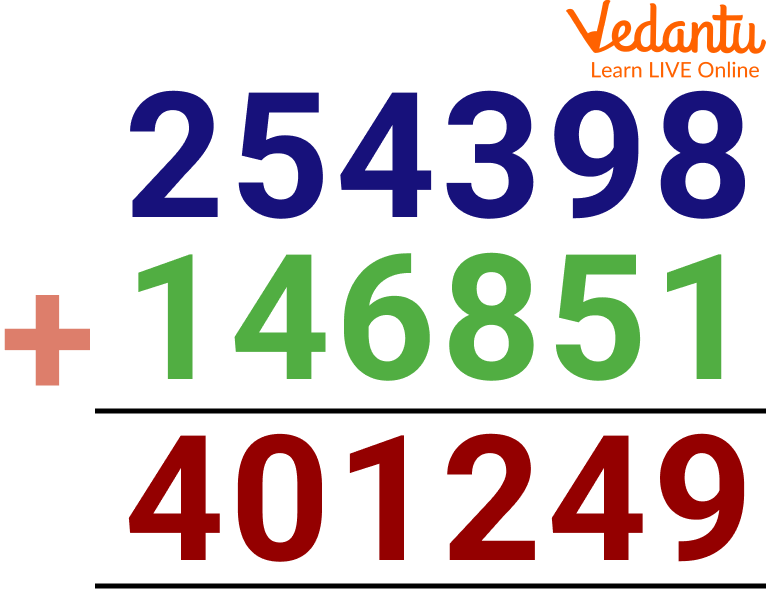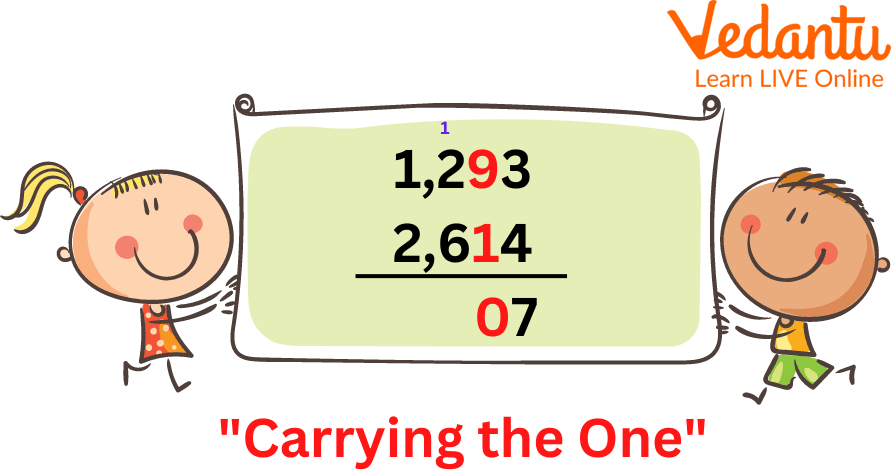




An Overview of the Addition of Numbers
Addition is the first arithmetic calculation that we learn in the mathematical world. The addition is the basic step to moving further into the core of mathematics. In the mathematical world, addition is the way of combining things and counting all of them together as one large group. Addition can be done with any positive number, integers, and real numbers.
The symbol of addition is a plus sign (+). It is one of the four basic operations of arithmetic. To perform this type of calculation a very simple set of rules is required to follow. Further in this article, we will talk about the addition of large numbers, the addition of whole numbers, adding numbers, and what do you mean by add number.
What is an Addition of Number?
Add number is nothing but the addition of two numbers. The addition symbol “+” is used to indicate adding two or more numbers. An add number is the addition of two unknown numbers and then getting one result. For example, 5+3 we will read this number as 5 plus 3 and the result will be 8.
Interestingly, the two or more values that are added together are called addends. Now, an additional sentence is just a mathematical expression that shows two or even more values that are added together and their sum is searched.

Addition Symbol
Addition of Large Numbers
Addition can be done using any kind of positive number in the mathematical world. One must know the method of addition, that's all. Initially, we start learning addition using small or single-digit numbers but, they can be done with larger numbers as well. But, before going to large numbers one must know these simple steps for addition.
The steps are as follows:-
The first step is to stack the numbers according to their place value.
The second step is to add the numbers starting from the right side of the column.
If there are carry numbers then that will go to the left-hand side as needed. This process should be continued if there are many numbers to be calculated.
Here is an example of the addition of large numbers for the kids out there.

Addition of Two Numbers.
One must start from the right-hand side while adding any number. The first step here is 8+1=9. Then there is 5+9=14 so you will need to write 4 below and 1 will carry forward to the next column for addition. Followed by 8+3=11+1=12, we need to write 2 below and 1 will carry forward to the next column. There is 4+6=10+1=11, 1 will be written below and 1 will be carried forward to the next column. There is 4+5=9+1=10, 0 will be written below and 1 will be carried forward to the next column. The last column is 2+1=3+1=4, which will be written below.

Carry Over While Adding Two Numbers
Addition of Whole Numbers
Before making any addition one must know what are whole numbers. Whole numbers are all the numbers but they start from 0. It is all the counting numbers that we use in daily lives but including 0.
Any number used for addition is a whole number. For example, 0+2=2 is an addition done by using two whole numbers. Another example of the addition of whole numbers (115 + 37 = 152) is a great example of the addition of whole numbers. There are some great examples of adding numbers for kids to understand.
Big Addition Sums
Now, we are quite sure kids will be able to solve addition with whole numbers and large numbers. But, there is a correct saying “Practice makes a man perfect” which is quite accurate. Mathematics is such a subject that not only requires understanding but, it requires a lot of practice to become better at it.
By now the little ones must develop a love for maths by understanding them and solving tricky questions and sums. The more the difficulty the more interesting it becomes for the little ones out there. Here are some big addition sums along with their answers just write in the column and add:-
72956 and 62450= 135406
198765, 500321, and 4056= 703142
980, 280, 480, and 112= 1852
56879 and 63275= 120154
These are some examples of big addition sums for kids to try on their own with other numbers after understanding.

Big Addition Sum
Here we have added numbers according to their place values, for example from 587 we took 500 and from 474 we took 400 for hundreds position then added together. Similarly for tens position we took 80 and 70 and for ones position we added 7 and 4. Then we added all these together to get the sum.
Solved Examples
Ques 1. Add 4372 and 2125.
Ans. Write the digits in column form, then start adding the numbers from the right side then move to the left side. Add all the digits one by one and write their sum corresponding to the digits.
Thus the addition of 4372 and 2125 is 6497.
Ques 2. Solve: 34246+3523
Ans. Write the digits in column form, then start adding the numbers from the right side then move to the left side. Add all the digits one by one and write their sum corresponding to the digits.
Thus the addition of 34246 and 3523 is 37769.
Practice Questions
Solve the following big addition sums:
Q 1. 525 + 25 + 40
Ans: 590
Q 2. 19 + 52 + 61
Ans: 132
Q 3. 637 + 400
Ans: 1037
Q 4. 968 + 875 + 682
Ans: 2525
Q 5. 533348 + 366992
Ans: 900340
Q 6. 621239 + 155632 + 119215
Ans: 896086
Summary
The addition is the basic form of mathematics. There are numerous activities where a child can learn addition at school and home. If the basics are taught and learned well then there is no falling back for the little ones. Moreover, we are quite sure that the kids now have a little idea of how to do addition and what are their processes. In this article, we have learned about what add numbers are, the addition of numbers, which are whole and large, and big addition sums.
FAQs on Addition of Numbers
1. What is the basic concept of addition in Maths?
In mathematics, addition is the fundamental process of combining two or more numbers or quantities to find their total value, known as the sum. For example, if you have 3 pencils and you get 2 more, adding them together (3 + 2) gives you a total of 5 pencils.
2. What are the key terms used in an addition problem?
The primary terms used in an addition problem are:
- Addends: These are the numbers that are being added together. For example, in the equation 7 + 8 = 15, the numbers 7 and 8 are the addends.
- Sum: This is the result or the final answer obtained after adding the addends. In the same example, 15 is the sum.
3. What are the main properties of addition for students?
The main properties of addition that are important for students to understand are:
- Commutative Property: This states that changing the order of the addends does not change the sum (e.g., 4 + 6 = 6 + 4).
- Associative Property: This states that when adding three or more numbers, the way they are grouped does not affect the sum (e.g., (2 + 3) + 5 = 2 + (3 + 5)).
- Additive Identity Property: This states that adding zero to any number does not change the number's value (e.g., 9 + 0 = 9).
4. What is 'carrying over' or 'regrouping' in addition?
Carrying over, also known as regrouping, is a technique used in multi-digit addition when the sum of a column is 10 or greater. For instance, when adding 28 + 15, the sum of the ones column (8 + 5) is 13. We write down the 3 in the ones place and 'carry over' the 1 (representing 10) to the top of the tens column to be added with the other tens.
5. How can addition be used in real-world situations?
Addition is used constantly in everyday life. Common examples include calculating the total cost of items when shopping, finding the total score in a game, figuring out the total distance when travelling between multiple locations, or simply counting the total number of objects in different groups.
6. Why does the order of numbers not matter when we add them?
The order of numbers doesn't matter in addition because of the Commutative Property. This principle reflects that addition is simply about combining quantities. Whether you start with a group of 5 items and add a group of 3, or start with 3 and add 5, the final combined total will always be 8. The total quantity is independent of the sequence of combination.
7. How does a number line help in understanding addition?
A number line provides a powerful visual tool for understanding addition. To perform an addition like 4 + 3, you start at the first number (4) on the line. Then, you move to the right by the number of units you are adding (3 units). The point where you land, which is 7, is the sum. This transforms the abstract calculation into a concrete action of movement.
8. How is addition related to subtraction?
Addition and subtraction are inverse operations, which means they undo each other. They describe the relationship between a whole and its parts. For every addition fact, there are two corresponding subtraction facts. For example, if we know that 6 + 8 = 14, we also know that 14 - 8 = 6 and 14 - 6 = 8.
9. What is the main difference between adding whole numbers and adding numbers with decimals?
While the basic process of adding is the same, the crucial difference with decimals is the need to align the decimal points before adding. This ensures that you are adding corresponding place values together—ones with ones, tenths with tenths, and so on. Misaligning the decimal points is a common mistake that leads to an incorrect sum.









